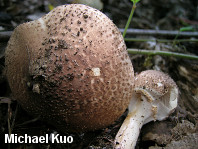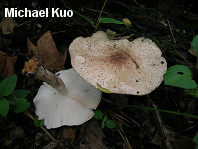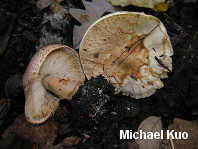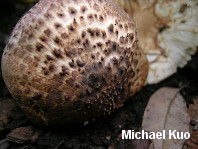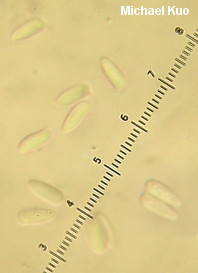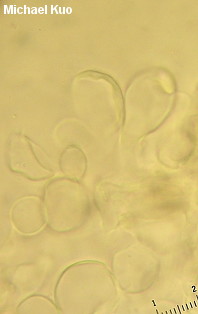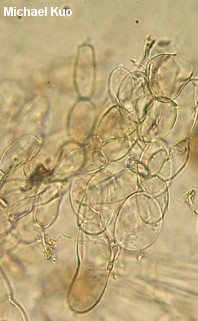| Major Groups > Gilled Mushrooms > Pale-Spored > Lepiotoid Mushrooms > Lepiota aspera |

|
Lepiota aspera [ Basidiomycota > Agaricales > Agaricaceae > Lepiota . . . ] by Michael Kuo In my area (central Illinois), Lepiota aspera appears in oak-hickory woods in late summer and fall. On casual inspection it looks a bit like an Amanita, but it lacks the distinctive stem base common to many Amanita species, and the scales on its cap are innate, rather than remnants of a veil. Crucial identification characters for Lepiota aspera include the orangish brown to pinkish brown cap that develops sharp little scales; the flimsy but somewhat persistent ring on the stem, which often has an underside decorated with scales like those on the cap; and microscopic features (see below). Lepiota asperula is nearly identical to the naked eye, but is on average a bit smaller; under the microscope, its spores are substantially smaller. Lepiota acutesquamosa (sometimes spelled "Lepiota acutaesquamosa") is a synonym; this name often appears in North American field guides. Description: Ecology: Saprobic; growing alone or scattered, usually in hardwood leaf litter or near woody debris; occasionally growing from well-rotted wood; late summer and fall; widely distributed in North America, but somewhat more common east of the Rocky Mountains. The illustrated and described collections are from Illinois. Cap: 4-10 cm across; convex to nearly round at first, becoming broadly convex or flat in age, but often retaining a shallow central bump; dry; when young densely covered with soft fibers that separate with development and become aggregated into small, sharp scales with maturity; orangish brown to pinkish brown overall when young; when mature with orangish brown to dark brown scales over a whitish to beige ground color that is exposed near the margin or nearly to the darker center. Gills: Free from the stem; crowded; white; at first covered by a white to pinkish or orangish partial veil that is dotted with small scales like the cap. Stem: 4-7 cm long; up to about 1 cm thick; more or less equal; dry; finely hairy; with a ragged, flimsy, but fairly persistent white to pinkish or orangish ring that cannot be easily detached and often features brown scales (like those on the cap) on its underside; whitish to pale brownish; hollowing; base attached to white rhizomorphs. Flesh: White; not changing when sliced. Odor: Usually not distinctive, but sometimes sweetly fragrant or slightly unpleasant. Chemical Reactions: KOH negative on cap surface. Spore Print: White. Microscopic Features: Spores 6-9 x 2-3 µ; long-ellipsoid to cylindric; smooth; hyaline to faintly ochraceous in KOH; dextrinoid; tending to cohere in groups when free floating. Cheilocystidia 20-35 x 7.5-15 µ; sphaeropedunculate to widely clavate; septate; hyaline in KOH; thin-walled. Pleurocystidia absent. Pileipellis an interwoven layer of cylindric hyphae REFERENCES: (Persoon, 1793) Quélet, 1886. (Fries, 1821; Saccardo, 1887; Phillips, 1981; Hansen & Knudsen, 1992; Breitenbach & Kränzlin, 1995; Vellinga, 2001h; Vellinga, 2003b; Kuo & Methven, 2014. Lepiota acutesquamosa: Kauffman, 1918; Kauffman, 1924; H. V. Smith, 1954; Smith, Smith & Weber, 1979; Bon, 1981; Lincoff, 1992; Barron, 1999; Miller & Miller, 2006.) Herb. Kuo 10050502, 09200601, 09220602, 10240701. This site contains no information about the edibility or toxicity of mushrooms. |
© MushroomExpert.Com |
|
Cite this page as: Kuo, M. (2015, September). Lepiota aspera. Retrieved from the MushroomExpert.Com Web site: http://www.mushroomexpert.com/lepiota_aspera.html |
